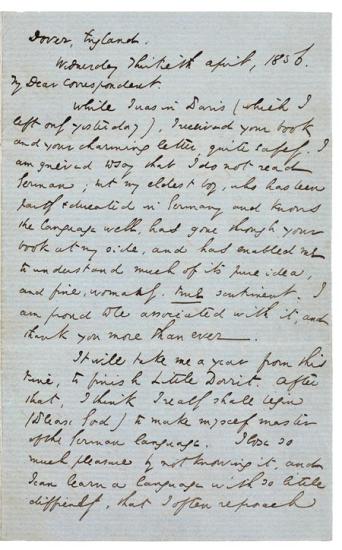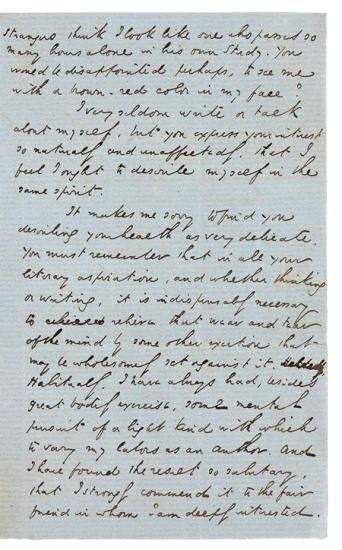Letter 1 | 30 April 1856 | to Sophie Verena, page 1

Autograph letter signed, Dover, 30 April 1856 to Sophie Verena
Purchased for The Dannie and Hettie Heineman Collection as the gift of the Heineman Foundation, 2011
This is an extraordinarily candid and personal letter to the young German novelist Sophie Verena, the pen name of Sophie Alberti, who dedicated her first novel to Dickens. Although it states: "I very seldom write or talk about myself," Dickens's letter describes in detail his physical appearance, exercise regimen, and writing habits. Asked whether he dictates his work, he tells Verena: "I answer with a smile that I can as soon imagine a painter dictating his pictures. No. I write every word of my books with my own hand.... I write with great care and pains (being passionately fond of my art, and thinking it worth any trouble)."
Manuscripts and Letters
The Morgan has the richest collection of Dickens manuscripts and letters in the United States. Dickens's letters are exceptionally brilliant and entertaining, and with his literary manuscripts, provide great insight into his craftsmanship and imagination, giving us the closest view of the novelist at work.
Dickens was careful, methodical, and painstaking in his work. Using a goose quill pen, he generally wrote from ten o'clock each morning until two in the afternoon, completing between two and four pages (or "slips," as he called them) each day. Except for letters, he wrote on only one side of the paper. In his early years, he favored black ink, now faded to brown, but in the late 1840s he switched to blue paper and blue ink, which dried more quickly. The handwriting in his early manuscripts is fluent, bold, and largely free of correction, suggesting "a hand racing to keep pace with the mind's conceptions." But, as he developed as an artist, his handwriting became increasingly small and compact, and his later manuscripts are more heavily revised and complex in appearance.
My Dear Correspondent.
While I was in Paris (which I left only yesterday), I received your book and your charming letter, quite safely. I am grieved to say that I do not read German; but my eldest boy, who has been partly educated in Germany and knows the language well, has gone through your book at my side, and has enabled me to understand much of its pure idea, and fine, womanly, true sentiment. I am proud to be associated with it, and thank you more than ever.
It will take me a year from this time, to finish Little Dorrit. After that, I think I really shall begin (Please God) to make myself master of the German language. I lose so much pleasure by not knowing it, and I can learn a language with so little difficulty, that I often reproach
Letter 1 | 30 April 1856 | to Sophie Verena, page 2

Autograph letter signed, Dover, 30 April 1856 to Sophie Verena
Purchased for The Dannie and Hettie Heineman Collection as the gift of the Heineman Foundation, 2011
This is an extraordinarily candid and personal letter to the young German novelist Sophie Verena, the pen name of Sophie Alberti, who dedicated her first novel to Dickens. Although it states: "I very seldom write or talk about myself," Dickens's letter describes in detail his physical appearance, exercise regimen, and writing habits. Asked whether he dictates his work, he tells Verena: "I answer with a smile that I can as soon imagine a painter dictating his pictures. No. I write every word of my books with my own hand.... I write with great care and pains (being passionately fond of my art, and thinking it worth any trouble)."
Manuscripts and Letters
The Morgan has the richest collection of Dickens manuscripts and letters in the United States. Dickens's letters are exceptionally brilliant and entertaining, and with his literary manuscripts, provide great insight into his craftsmanship and imagination, giving us the closest view of the novelist at work.
Dickens was careful, methodical, and painstaking in his work. Using a goose quill pen, he generally wrote from ten o'clock each morning until two in the afternoon, completing between two and four pages (or "slips," as he called them) each day. Except for letters, he wrote on only one side of the paper. In his early years, he favored black ink, now faded to brown, but in the late 1840s he switched to blue paper and blue ink, which dried more quickly. The handwriting in his early manuscripts is fluent, bold, and largely free of correction, suggesting "a hand racing to keep pace with the mind's conceptions." But, as he developed as an artist, his handwriting became increasingly small and compact, and his later manuscripts are more heavily revised and complex in appearance.
myself for not having acquired it long ago. I am not so young as I am in the picture you have seen, for that was painted some fifteen years ago, and I am now 44. It looks a good deal, on paper, I find; but I believe I am very young-looking still, and I know that I am a very active vigorous fellow, who never knew in his own experience what the word "fatigue" meant.
This is in answer to your first question. In reply to your second question whether I dictate, I answer with a smile that I can as soon imagine a painter dictating his pictures. No. I write every word of my books with my own hand, and do not write them very quickly either. I write with great care and pains (being passionately fond of my art, and thinking it worth any trouble), and persevere, and work hard. I am a great walker besides, and plunge into cold water every day in the dead of winter. When I was last in Switzerland, I found that I could climb as fast as the Swiss Guides. Few
Letter 1 | 30 April 1856 | to Sophie Verena, page 3

Autograph letter signed, Dover, 30 April 1856 to Sophie Verena
Purchased for The Dannie and Hettie Heineman Collection as the gift of the Heineman Foundation, 2011
This is an extraordinarily candid and personal letter to the young German novelist Sophie Verena, the pen name of Sophie Alberti, who dedicated her first novel to Dickens. Although it states: "I very seldom write or talk about myself," Dickens's letter describes in detail his physical appearance, exercise regimen, and writing habits. Asked whether he dictates his work, he tells Verena: "I answer with a smile that I can as soon imagine a painter dictating his pictures. No. I write every word of my books with my own hand.... I write with great care and pains (being passionately fond of my art, and thinking it worth any trouble)."
Manuscripts and Letters
The Morgan has the richest collection of Dickens manuscripts and letters in the United States. Dickens's letters are exceptionally brilliant and entertaining, and with his literary manuscripts, provide great insight into his craftsmanship and imagination, giving us the closest view of the novelist at work.
Dickens was careful, methodical, and painstaking in his work. Using a goose quill pen, he generally wrote from ten o'clock each morning until two in the afternoon, completing between two and four pages (or "slips," as he called them) each day. Except for letters, he wrote on only one side of the paper. In his early years, he favored black ink, now faded to brown, but in the late 1840s he switched to blue paper and blue ink, which dried more quickly. The handwriting in his early manuscripts is fluent, bold, and largely free of correction, suggesting "a hand racing to keep pace with the mind's conceptions." But, as he developed as an artist, his handwriting became increasingly small and compact, and his later manuscripts are more heavily revised and complex in appearance.
strangers think I look like one who passes so many hours alone in his own Study. You would be disappointed perhaps, to see me with a brown-red color in my face?
I very seldom write or talk about myself, but you express your interest so naturally and unaffectedly, that I feel I ought to describe myself in the same spirit.
It makes me sorry to find you describing your health as very delicate. You must remember that in all your literary aspiration, and whether thinking or writing, it is indispensably necessary to relieve that wear and tear of the mind by some other exertion that may be wholesomely set against it. Habitually, I have always had, besides great bodily exercise, some mental pursuit of a light kind with which to vary my labors as an Author. And I have found the result so salutary, that I strongly commend it to the fair friend in whom I am deeply interested.
Letter 1 | 30 April 1856 | to Sophie Verena, page 4

Autograph letter signed, Dover, 30 April 1856 to Sophie Verena
Purchased for The Dannie and Hettie Heineman Collection as the gift of the Heineman Foundation, 2011
This is an extraordinarily candid and personal letter to the young German novelist Sophie Verena, the pen name of Sophie Alberti, who dedicated her first novel to Dickens. Although it states: "I very seldom write or talk about myself," Dickens's letter describes in detail his physical appearance, exercise regimen, and writing habits. Asked whether he dictates his work, he tells Verena: "I answer with a smile that I can as soon imagine a painter dictating his pictures. No. I write every word of my books with my own hand.... I write with great care and pains (being passionately fond of my art, and thinking it worth any trouble)."
Manuscripts and Letters
The Morgan has the richest collection of Dickens manuscripts and letters in the United States. Dickens's letters are exceptionally brilliant and entertaining, and with his literary manuscripts, provide great insight into his craftsmanship and imagination, giving us the closest view of the novelist at work.
Dickens was careful, methodical, and painstaking in his work. Using a goose quill pen, he generally wrote from ten o'clock each morning until two in the afternoon, completing between two and four pages (or "slips," as he called them) each day. Except for letters, he wrote on only one side of the paper. In his early years, he favored black ink, now faded to brown, but in the late 1840s he switched to blue paper and blue ink, which dried more quickly. The handwriting in his early manuscripts is fluent, bold, and largely free of correction, suggesting "a hand racing to keep pace with the mind's conceptions." But, as he developed as an artist, his handwriting became increasingly small and compact, and his later manuscripts are more heavily revised and complex in appearance.
I am now upon my way home, merely staying here a couple of days to have some walks on the high cliffs by the sea. During the summer, I shall be generally at a little French Country House among pleasant gardens near Boulogne Sur Mer. But that is only a few hours journey from London, and I shall receive my letters and papers from thence, two or three times a week. My best address therefore, is at my own house
Tavistock House
London
— and there I shall always be delighted to hear from you. Perhaps I may see you there one day? If not, I must come to Potsdam after I have learnt German from your book.
Farewell. God bless you! Always believe me, with great regard,
Your affectionate
CHARLES DICKENS